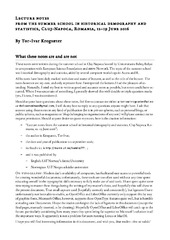The Vicar , the Nobleman, and the Peasant: About a Book and its Readers
Permanent link
https://hdl.handle.net/10037/29260Date
2022-11-22Type
Journal articleTidsskriftartikkel
Peer reviewed
Author
Hansen, Poul Henning GustafAbstract
This article centres around a volume of sermons and its three documented owners. The book first belonged to a vicar, then to a nobleman, and finally to a farmhand. The three owners all left marks on the book, and the farmhand wrote a remarkable passage on its last page, detailing his reading of the book. The three owners’ possession of the book spans over a century, 1766–1876, a period that saw people’s reading habits and reading practices transform fundamentally. In this context Sweden, a forerunner in literacy development, constitutes a particularly interesting example. The journey that this book made provides an insight into provincial book culture and reading practices, and also tells us something about the literacy development of the time. Linking the reading practices to socioeconomic status, the article suggests that the habit of rereading lived on among uneducated readers in the countryside for quite some time. Le présent article porte sur un recueil de sermons et sur les trois personnes dont on peut attester qu’elles en ont été propriétaires. Le recueil appartint d’abord à un vicaire, puis à un noble et, enfin, à un ouvrier agricole. Ces trois propriétaires y laissèrent des traces, l’ouvrier agricole, notamment, ayant consigné de remarquables notes lecture à la dernière page du livre. À tour de rôle, ils eurent le recueil en leur possession durant plus d’un siècle, de 1766 à 1876, période qui vit les habitudes et pratiques de lecture se transformer en profondeur. La Suède, précurseure en matière de littératie, constitue en cela un exemple particulièrement intéressant. En effet, les « pérégrinations » du recueil donnent à voir quelles étaient la culture du livre et les pratiques de lecture en province, tout comme elles sont révélatrices des progrès sur le plan de la littératie. En établissant des liens entre pratiques de lecture et statut socioéconomique, l’article révèle entre autres que la relecture fut durant longtemps chose courante, à la campagne, chez les lecteurs peu scolarisés.
Publisher
ÉruditCitation
Hansen PHG. The Vicar , the Nobleman, and the Peasant: About a Book and its Readers. Mémoires du livre. 2022;13(1)Metadata
Show full item recordCollections
Copyright 2022 The Author(s)
Except where otherwise noted, this item's license is described as Attribution-NonCommercial-NoDerivatives 4.0 International (CC BY-NC-ND 4.0)
Related items
Showing items related by title, author, creator and subject.
-
Lecture notes from the summer school in historical demography and statistics, Cluj-Napoca, Romania, 12–19 June 2016
Krogsæter, Tor-Ivar (Lecture; Forelesning, 2016-06-19) -
Folkemordet i Rwanda - Voldens brutalitet og sivile aktørers deltagelse
Kolstad, Charlotte Renland (Master thesis; Mastergradsoppgave, 2014-05-15)I 1994 ble rundt 800 000 mennesker drept i et lite sentralafrikansk land, størrelsen på landet kan sammenlignes med Troms fylke i Norge. Hendelsen er kjent som folkemordet i Rwanda. I senere tid har det blitt utgitt et relativt bredt spekter av litteratur på feltet, hvor forskere har hatt forskjellige ståsteder som har resultert i ulike synsvinklinger. Prosjektet tar for seg sentrale oppfatninger ... -
Kvinner i sovjetisk og russisk krigsfilm - offer og moralske førebilete
Høgetveit, Åsne Øysteinsdotter (Master thesis; Mastergradsoppgave, 2014-05-16)Oppgåva undersøker korleis kvinnelege soldatar vert framstilt i filmane A zori zdes’ tikhie (Rostotskij 1972) og Leningrad (Buravskij 2007). Om lag ein million kvinner tenestegjorde i dei sovjetiske styrkane under andre verdskrigen. Kvinners krigsdeltaking gjekk langt utover dei tradisjonelle kvinneoppgåvene som helsepersonell og innom administrasjon: Kvinnelege soldatar var skarpskyttarar, pilotar, ...


 English
English norsk
norsk



